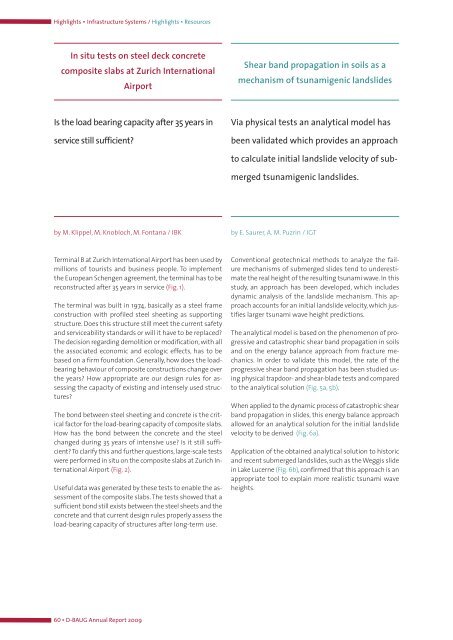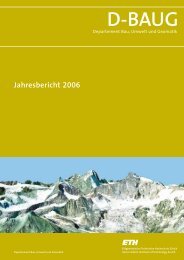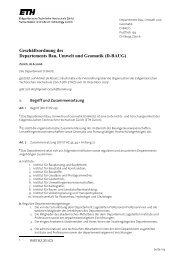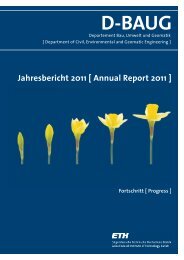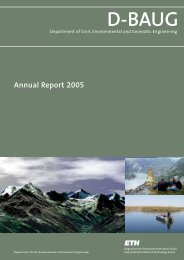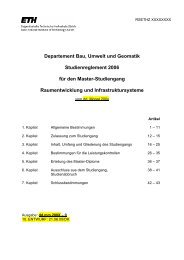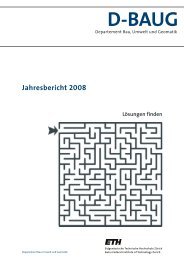D-BAUG - Departement Bau, Umwelt und Geomatik - ETH Zürich
D-BAUG - Departement Bau, Umwelt und Geomatik - ETH Zürich
D-BAUG - Departement Bau, Umwelt und Geomatik - ETH Zürich
Create successful ePaper yourself
Turn your PDF publications into a flip-book with our unique Google optimized e-Paper software.
Highlights ▪ Infrastructure Systems / Highlights ▪ Resources<br />
In situ tests on steel deck concrete<br />
composite slabs at Zurich International<br />
Airport<br />
Is the load bearing capacity after 35 years in<br />
service still sufficient?<br />
by M. Klippel, M. Knobloch, M. Fontana / IBK<br />
Terminal B at Zurich International Airport has been used by<br />
millions of tourists and business people. To implement<br />
the European Schengen agreement, the terminal has to be<br />
reconstructed after 35 years in service (Fig. 1).<br />
The terminal was built in 1974, basically as a steel frame<br />
construction with profiled steel sheeting as supporting<br />
structure. Does this structure still meet the current safety<br />
and serviceability standards or will it have to be replaced?<br />
The decision regarding demolition or modification, with all<br />
the associated economic and ecologic effects, has to be<br />
based on a firm fo<strong>und</strong>ation. Generally, how does the loadbearing<br />
behaviour of composite constructions change over<br />
the years? How appropriate are our design rules for assessing<br />
the capacity of existing and intensely used structures?<br />
The bond between steel sheeting and concrete is the critical<br />
factor for the load-bearing capacity of composite slabs.<br />
How has the bond between the concrete and the steel<br />
changed during 35 years of intensive use? Is it still sufficient?<br />
To clarify this and further questions, large-scale tests<br />
were performed in situ on the composite slabs at Zurich International<br />
Airport (Fig. 2).<br />
Useful data was generated by these tests to enable the assessment<br />
of the composite slabs. The tests showed that a<br />
sufficient bond still exists between the steel sheets and the<br />
concrete and that current design rules properly assess the<br />
load-bearing capacity of structures after long-term use.<br />
60 ▪ D-<strong>BAUG</strong> Annual Report 2009<br />
Shear band propagation in soils as a<br />
mechanism of tsunamigenic landslides<br />
Via physical tests an analytical model has<br />
been validated which provides an approach<br />
to calculate initial landslide velocity of sub-<br />
merged tsunamigenic landslides.<br />
by E. Saurer, A. M. Puzrin / IGT<br />
Conventional geotechnical methods to analyze the failure<br />
mechanisms of submerged slides tend to <strong>und</strong>erestimate<br />
the real height of the resulting tsunami wave. In this<br />
study, an approach has been developed, which includes<br />
dynamic analysis of the landslide mechanism. This approach<br />
accounts for an initial landslide velocity, which justifies<br />
larger tsunami wave height predictions.<br />
The analytical model is based on the phenomenon of progressive<br />
and catastrophic shear band propagation in soils<br />
and on the energy balance approach from fracture mechanics.<br />
In order to validate this model, the rate of the<br />
progressive shear band propagation has been studied using<br />
physical trapdoor- and shear-blade tests and compared<br />
to the analytical solution (Fig. 5a, 5b).<br />
When applied to the dynamic process of catastrophic shear<br />
band propagation in slides, this energy balance approach<br />
allowed for an analytical solution for the initial landslide<br />
velocity to be derived (Fig. 6a).<br />
Application of the obtained analytical solution to historic<br />
and recent submerged landslides, such as the Weggis slide<br />
in Lake Lucerne (Fig. 6b), confirmed that this approach is an<br />
appropriate tool to explain more realistic tsunami wave<br />
heights.


